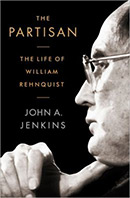The Partisan: The Life of William Rehnquist

Author: John A. Jenkins
Publisher: New York: PublicAffairs, 2012. 330p.
Reviewer: Jordan Rubin | March 2013
Readers are forewarned when John A. Jenkins, author of The Partisan, cautions that “[a]nyone looking for a comprehensive survey of [William] Rehnquist’s jurisprudence . . . will not find it here.” Nonetheless, this biography does offer some insight into our late Chief Justice’s approach to criminal law, although Jenkins’s analysis, at times, suffers ironically from its own form of partisanship.
Jenkins draws from at least three distinct sources to paint his picture of Rehnquist’s judicial philosophy: 1) neo-conservative political expedience, 2) a professor Rehnquist had in college, and 3) a nineteenth century judge from Arkansas. For starters, an attempt to pin down Jenkins’s theory of Rehnquist’s criminal law jurisprudence should focus on the author’s consistent mention of the Chief’s divulgence that he decided cases according to which side he thought had “the better point of view.” Rehnquist’s view, as Jenkins sees it, amounted to this: “If you were a homosexual, a racial or religious minority, a woman, an alien, an accused criminal, or someone facing the death penalty, you were not going to get Rehnquist’s vote.” This is a broad pronouncement, but in some ways it isn’t too far off. One exception to Jenkins’s assessment, however, would seem to be the Supreme Court’s decision in Dickerson v. United States (2000), upholding the viability of the Miranda warnings, which, hopefully, readers have heard recited only on Law & Order. Then-Chief Justice Rehnquist authored Dickerson, and some scholars have puzzled over his seeming betrayal of his otherwise unflappably conservative record, as the Miranda warnings were long hailed (or bemoaned) as a staple of the liberal Warren Court—Rehnquist’s bête noire. Indeed, Jenkins notes that when Rehnquist was a lawyer for the Nixon Justice Department, not long before he was nominated and confirmed as an associate justice of the Supreme Court, he wrote a memo in which he deemed Miranda and other Warren Court criminal law precedents to be ill-conceived.
So how does Jenkins square a case like Dickerson with his theory of Rehnquist’s anti-liberal, “better point of view” jurisprudence? He surmises that Rehnquist’s decision in Dickerson was written to make police officers’ lives easier, because a decision declaring the Miranda warnings unnecessary would have created a situation in which some officers might be told to stop using the warnings altogether, thus bringing about a potentially annoying change in cops’ daily routines. Therefore, Jenkins concludes that Dickerson “actually comported with Rehnquist’s law-and-order credo in some way.”
In addition to the “better point of view” rationale, a second theme of Jenkins’s in assessing Rehnquist’s criminal law jurisprudence is the influence of one of Rehnquist’s college professors at Stanford, Charles Fairman, who, Jenkins writes, was both “a darling of the political right at a time of great racial upheaval in postwar America” and “Rehnquist’s mentor and role model.” Fairman assigned his constitutional law class a book that was the first that Rehnquist had ever read on the U.S. Constitution. (It was written by Professor Fairman, of course.) The book was a biography of former Supreme Court Justice Samuel Miller, who served during the time of Abraham Lincoln. According to Jenkins, “[Miller] . . . played an important role in limiting the Supreme Court’s interpretation of the three constitutional amendments collectively known as the Civil War Amendments [(the Thirteenth, Fourteenth, and Fifteenth)].” Fairman sympathized with Miller’s view, and, more generally, with the notion of “inherent danger from an infringing central government.” From this, Jenkins traces Fairman’s influence to then-Chief Justice Rehnquist’s 5-4 opinion for the Court in United States v. Morrison (2000), which struck down the provision of the Violence Against Women Act that allowed victims of gender-motivated violence to sue their attackers in federal court. The Rehnquist-led majority relied partly on United States v. Harris (1883) and The Civil Rights Cases (1883)—cases which, broadly speaking, emphasized the limited powers of the federal government—in interpreting the Fourteenth Amendment; Jenkins argues that Fairman’s teaching was evident in Rehnquist’s opining that the matter sub judice—violence against women—was better left to the states, based on Rehnquist’s (via Fairman’s) reading of the framers’ intent.
A third, and perhaps the most harped-on theory by the author, is Rehnquist’s documented admiration of Judge Isaac Parker, “the hanging judge,” who served the U.S. District Court for the Western District of Arkansas in the late-nineteenth century. Judge Parker’s career was notable for the alacrity with which he ordered the executions of condemned criminals, “carr[ying] out more death sentences, more quickly, than anyone else in American history.” Rehnquist was apparently fascinated with this judge, and Jenkins is apparently fascinated with Rehnquist’s fascination, dedicating an entire chapter (Chapter Eight) to the judicial kinship, and consistently referencing the hanging judge and how his impact is evident in Rehnquist’s legal opinions. When Parker arrived on the federal bench, his death sentences were not reviewable, owing to congressional failure to provide jurisdiction for such appeals, and “[a]fter Supreme Court review was instituted, Parker complained that many of his sentences were overturned on technicalities—an opinion with which Rehnquist agreed.” One of Jenkins’s motifs of Rehnquist’s jurisprudence is a disdain for appellate review generally, and the author leans heavily on Judge Parker as empirical support for this legal viewpoint.
The “Hanging Judge” chapter is actually one of the headier sections of the book in terms of legal discussion, and it is there that Jenkins cites several laws and opinions to either imply or explicitly state Judge Parker’s influence on Rehnquist’s criminal law philosophy, including: Gray v. Lucas (a 1983 denial of a stay of execution in which then-Associate Justice Rehnquist concurred, a case he considered to be an example of the over-generosity of modern habeas corpus law); Furman v. Georgia (the 1972 case invalidating the death penalty where Rehnquist “led[] the four new Nixon appointees in dissent”); Gregg v. Georgia (the 1976 case reinstating the death penalty where Rehnquist was in the majority); McCleskey v. Kemp (the 1987 case on racial disparities in the distribution of capital punishment, where, as Jenkins puts it, “with Rehnquist now the new chief justice, the Court closed off yet another line of attack on death penalty”); the Antiterrorism and Effective Death Penalty Act of 1996 (AEDPA) (limiting habeas petitions), and Felker v. Turpin (a unanimous 1996 opinion written by Rehnquist affirming the constitutionality of the AEDPA). With all of this cited, Jenkins looks back and concludes that “one would find it all too easy to see Rehnquist’s continuing admiration of Hanging Judge Parker.” It’s hard to say whether Rehnquist was thinking about Parker when he put his pen to paper, but to Jenkins’s credit, the author comes closer to engaging in a thorough review of Rehnquist’s legal opinions than he likes to admit. Yet, Jenkins doesn’t seem to mention, and certainly doesn’t emphasize, the fact that Parker was personally opposed to capital punishment. Whether this makes the Parker-Rehnquist connection flimsier I don’t know, but given the overall tone of The Partsian, which gives no quarter to the old Chief, it would have made sense not only for Jenkins to highlight the apparent contradiction in Rehnquist’s admiration of someone whose personal belief was so opposite his own, but to hammer away at Rehnquist for being so blind as to not realize the paradox. Of course, if Rehnquist was as obsessed with Parker as Jenkins says, then Rehnquist likely knew his views on capital punishment.
So there we have three potential theories for Jenkins’s view of Rehnquist’s criminal justice philosophy: 1) ultra-conservative gut instincts, 2) a college professor, and 3) a “hanging judge.” It might be more complex than this, but Jenkins doesn’t think so, as he writes, “[w]ith Rehnquist’s credo one didn’t have to connect many dots. It was a simple politico-judicial philosophy.” Jenkins sizes Rehnquist up and concludes that “[his] self assurance reflected the majoritarian homogeneity of Shorewood[, Wisconsin, Rehnquist’s hometown,] and the simplicity of an earlier time when white men ruled. . . . If you were not in the majority you could not expect protection against the majority’s views, except in the few narrow, negative areas.” The Partisan is full of such anti-Rehnquistian aphorisms, many more than can fit in this review.
On the whole, Jenkins addresses case law to the extent that it fits within his view of Rehnquist’s politics. If Rehnquist is just a politician in robes, then treating the topic this way makes perfect sense. Unfortunately, however, Jenkins’s laser-like focus on Rehnquist’s conservatism sometimes forces the author to bring himself down along with his subject. For example, Jenkins cites Coleman v. Balkcom (1981), an unsuccessful petition for certiorari in a death penalty case, to support his allegation of Rehnquist’s narrow-mindedness. Coleman is an interesting vote line-up, with one dissent written by Justice Thurgood Marshall, dutifully joined by Justice William Brennan, and another written by then-Justice Rehnquist. Rehnquist dissented because, according to Jenkins, “[he] wanted to crank up the electric chair, and he contended that the way to do that was for the Court to accept every death-penalty case until the backlogs on death row were cleared.” Jenkins describes Rehnquist’s opinion as “a live hand grenade being rolled into the middle of the [justices’] conference table. . . . He even quoted Judge Parker, the hanging judge, in a footnote.” This analysis captures not only Rehnquist’s legacy, but Jenkins’s myopia, where the author writes, “[n]ormally it was the liberals who argued for granting certiorari in death-penalty cases, as a way of slowing the pace of executions (indeed, Marshall and Brennan were also dissenters in this case).” The clear irony here is that Jenkins picks Coleman as an example of Rehnquist’s extremism (“his invidious dissent”), but in that same case, Justices Brennan and Marshall were after a result on the opposite end of the ideological spectrum. To the degree that Rehnquist’s opinion was the more extreme of the two, it would have been helpful for Jenkins to point out Marshall’s and Brennan’s view that capital punishment was always unconstitutional. With the benefit of full information, readers would understand that Coleman is nothing more than competing ends at play, instead of one side playing by the rules while the other plays politics.
Thus, The Partisan has its shortcomings in the realm of legal analysis; Jenkins sort of admits this upfront. But the author’s true specialty as a journalist shines through as he combs the minutiae of Rehnquist’s life to discover, among other gems, Rehnquist’s changing his middle name from “Donald” to “Hubbs,” on the advice of his mother’s numerologist, who thought that her son would go on to be successful if his middle name began with an “H.” It’s tough to prove a negative.
Speaking of eccentric superstition, a comparison of The Partisan to a recently published book on Scientology, of all things, shows that Jenkins’s deconstruction of Rehnquist could have been stronger. A review of the Scientology book praises the author by opining that “[t]hat crunching sound you hear” is the author bending over backward to be fair to his subject, and the reviewer incisively concludes that “[t]his [bending] makes the book’s indictment [of Scientology] that much more powerful.” Jenkins, on the other hand, doesn’t really bend at all, and the power of his indictment diminishes accordingly. He doesn’t have to bend, of course, but The Partisan’s rhetoric—which casts Rehnquist as some sort of comic book villain: “the young reactionary,” “controlled” by an ideology that commands him to wage “jihad” against liberal ideals and “shatter” stare decisis—might leave readers wondering if they hadn’t picked up the Scientology book by accident, as they read about a whacked-out leader of a suspect sect, who damned all naysayers and left a charming acolyte to carry the torch (think John Roberts as Tom Cruise). In the end, with Rehnquist’s record before us, we can do like Judge Parker (and Jenkins), and promptly hang Rehnquist’s legacy high, or we can stay the old Chief’s reputational execution, and afford his champions the right to a last-ditch appeal. Maybe more than one.
Jordan Rubin is a 2012 graduate of Rutgers School of Law – Newark. His essay on the death penalty’s complicated relationship with the afterlife, Can I Get a Witness from the Population?!, is forthcoming in the Binghamton Journal of Philosophy (SUNY Press 2013).


